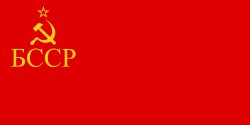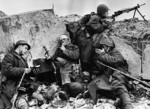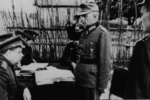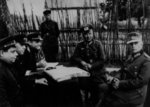
Byelorussia
| Full Name | 49 Socialist Soviet Republic of Byelorussia | |
| Alliance | Soviet Union - Minor Member Nation or Possession | |
| Possessing Power | Russia | |
| Population in 1939 | 9,000,000 | |
| Civilian Deaths in WW2 | 2,200,000 | |
| - Civ Deaths from Holocaust | 810,000 |
Contributor: C. Peter Chen
ww2dbaseThe Socialist Soviet Republic of Byelorussia was declared on 1 Jan 1919 as one of the original founding member nations of the Soviet Union. From the cultural perspective, Byelorussia was slowly Russified; one such example of the Byelorussian language, which was suppressed as could be observed through the name of the nation. In the 1930s, Joseph Stalin's purges saw mass arrests, deportations, and executions of the Byelorussian intelligentsia. In 1937, the Soviet military had 15 infantry divisions and 5 cavalry divisions were stationed in Byelorussia; on 26 Jul 1938, the military district that defended the area was renamed the Belarussian Special Military District, or Bovo.
ww2dbaseIn Sep 1939, the Soviet Union and Germany jointly invaded Poland. The victory saw the expansion of Byelorussia, which annexed the region called West Byelorussia that had been administered by Poland. In Jul 1940, the military district that defended the region was renamed the Western Special Military District. When the Russo-German war began in mid-1941, the city of Minsk was bombed on the very first day of the invasion. As the newly re-designated Western Front successively fell back, Stalin decreed a scorched earth order, and everything that could be of use to the Germans was destroyed; with this order, Byelorussian food stores and infrastructure were devastated. Furthermore, about 4,000 towns and villages were completely destroyed through both Soviet sabotage and combat. In a stunning feat, entire factories were uprooted by the Russians to be re-established to the east; the industries that the Russians could not relocate were destroyed much like the infrastructure.
ww2dbaseGerman Occupation
ww2dbaseBy Aug 1941, all of Byelorussian territory had been captured by German troops, and shortly after the German-sponsored government of the Byelorussian Central Rada was established at Minsk, but it had very little real power. A large collaborationist group initially presented itself, welcoming the Germans as liberators who had removed the repressive Soviet government. Although many Byelorussians would maintain this belief, as time went on and words of German atrocities spread, more and more people either sided with those who wanted to bring back the Soviets, or more likely, sided with groups who wanted a truly independent Byelorussia.
ww2dbaseBy 1942, anti-German resistance groups became well organized despite the number being very small; estimate of the strength of Byelorussian partisan groups in 1942 only run between 10,000 to 20,000 men. Partisan groups hiding in woods and swamps struck out unexpectedly against rail tracks, roads, and bridges used by the Germans, as well as telephone lines, supply depots, even German troop formations. Some of the groups were Soviet-aligned, while others were independent. Although the Germans never considered Byelorussian partisans a threat, they were certainty a nuisance, and anti-partisan operations tend to be brutal. At times entire villages were massacred or deported only on the suspicion that it was a base of a partisan group. One such example was the village of Dory, whose population was either burned alive at the church, deported to work camps, or, in the case of children, left to die in an untended rail car. In another example of anti-partisan brutality, to discourage partisan mining of roads, roads suspected to have been mined were walked by civilians who lived nearby before German troop formations marched down the same roads.
ww2dbaseSoviet troops returned to Byelorussia in mid-1944, with Minsk captured on 3 Jul. During the German occupation, at least 5,295 Byelorussian towns and villages were destroyed by the Germans, some of which were among the 4,000 destroyed during the German invasion, re-built, only to be burned down again either by the occupation or as the result of the new round of fighting. 380,000 Byelorussians of all ethnicities were deported as forced laborers for the German war effort. In terms of the Holocaust, 282,000 out of 375,100 Jews within the pre-1939 Byelorussia borders and 528,000 out of 723,500 Jews in the West Byelorussia territory gained from Poland were killed. While the Nazi Party men were certainly the architects of the Holocaust in Byelorussia, there were many Byelorussians who took active roles in the rounding up, deporting, and killing of Jews in their own country; the stereotype that linked communism and Jews played a role in this.
ww2dbaseAs the European War ended, a total of 2,230,000 Byelorussian civilians had lost their lives, which constituted about 25% of the country's population. The cities of Minsk and Vitsebsk were virtually destroyed after heavy fighting between German and Soviet troops; an estimated 80% of buildings and infrastructure in these cities were deemed destroyed.
ww2dbaseEpilogue
ww2dbaseAfter the war, the Byelorussian city of Minsk was given the title of Hero City for its contribution in the Russo-German war; the fortress of Brest was given the title of Hero Fortress. In 1945, Byelorussia became one of the founding members of the United Nations. In 1946, Marshal Semyon Timoshenko arrived in Minsk to serve as the commanding officer of the Byelorussian Military District; he would remain until 1949. Although the war was now over, Moscow opted not to return most of the industries that it had relocated into Russia in 1941; however, under strict supervision from Moscow, Byelorussian industrial capacity grew through the following few decades. On 27 Jul 1990, Byelorussia declared its independence, and on 25 Aug 1991, the Republic of Belarus was born; the change from Byelorussia to Belarus was to reflect its independence from Russian influence.
ww2dbaseSources:
John Mosier, Deathride
Wikipedia
Last Major Update: Jul 2010
| People | ||
| Astrouski, Radaslau | Ponomarenko, Panteleimon | Vituska, Michal |
| Masherov, Pyotr | Sukhoi, Pavel | |
| Events Taken Place in Byelorussia | ||
| Operation Barbarossa | 22 Jun 1941 - 30 Sep 1941 | |
| Khatyn Massacre | 22 Mar 1943 | |
| Operation Bagration | 22 Jun 1944 - 29 Aug 1944 | |
| Discovery of Concentration Camps and the Holocaust | 24 Jul 1944 - 29 Apr 1945 | |
Photographs
 |  |  |  |
Did you enjoy this article or find this article helpful? If so, please consider supporting us on Patreon. Even $1 per month will go a long way! Thank you. Share this article with your friends: Stay updated with WW2DB: |
- » WW2DB's 19th Anniversary (29 Dec 2023)
- » Looted Painting "Madonna with Child" Returned to Poland (2 Jun 2023)
- » Wreck of USS Mannert L. Abele Found (29 May 2023)
- » Wreck of Montevideo Maru Found (25 Apr 2023)
- » Accidental Detonation of a WW2-Era Bomb in Great Yarmouth (10 Feb 2023)
- » See all news
- » 1,146 biographies
- » 337 events
- » 43,422 timeline entries
- » 1,237 ships
- » 349 aircraft models
- » 207 vehicle models
- » 372 weapon models
- » 123 historical documents
- » 259 facilities
- » 468 book reviews
- » 28,395 photos
- » 432 maps
Captain Henry P. Jim Crowe, Guadalcanal, 13 Jan 1943
Please consider supporting us on Patreon. Even $1 a month will go a long way. Thank you!
Or, please support us by purchasing some WW2DB merchandise at TeeSpring, Thank you!